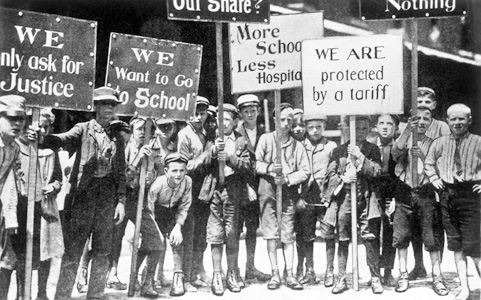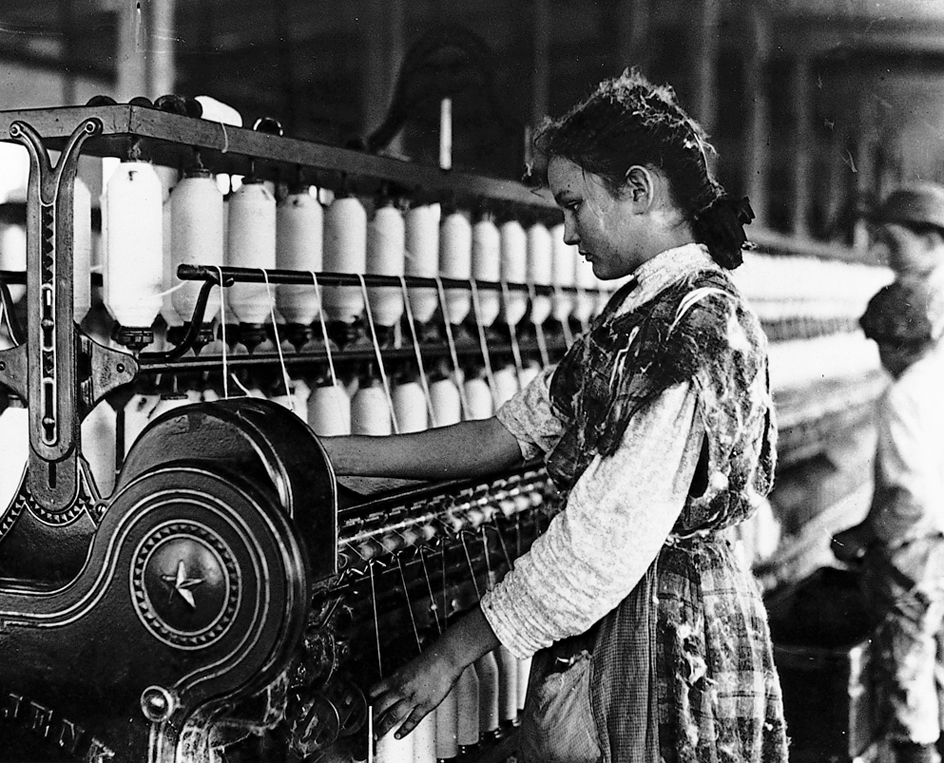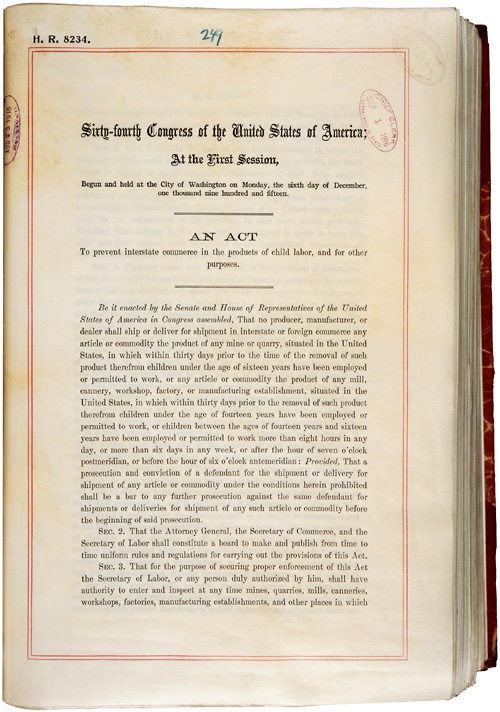Child labor is the employment of children as wage earners. It became a serious social problem during the Industrial Revolution in the United Kingdom during the 1700’s, and the problem spread to other countries as they became industrialized. The problem arose when children, many below the age of 10, were employed by factories and mines. The youths were forced to work long hours under dangerous and unhealthy conditions, and their wages were very small.

Social reformers began to condemn child labor practices because of their ruinous effect on the health and welfare of children. The most effective attack on the evils of child labor may have come from Charles Dickens’s novel Oliver Twist (1837-1839). The book was widely read in both the United States and the United Kingdom.
Gradually, countries passed laws to correct the abuses of child labor. Children still work today. In Australia, Canada, the United Kingdom, the United States, and many other countries, most working children are teenagers who hold part-time jobs. Their working conditions are carefully regulated by law. However, in Asia and other parts of the world, millions of boys and girls still hold full-time jobs. In some countries, children under 15 form a large part of the total working force, and there is little or no control over their working conditions. The International Labour Organization (ILO) Minimum Age Convention 138, adopted in 1973, calls on countries to prohibit child labor under the age of 15. However, not all countries have adopted this convention.
Abuses of child labor.
Since ancient times, children have worked to help support their families, especially on farms. But child labor created no major social problems until the factory system of labor began.
During the 1700’s, many businesses in the United Kingdom began to hire children. Children worked for lower wages than adults and were not so likely as adults to cause labor troubles. Factory owners wanted to use their small, nimble fingers for tending machines. Children worked for low pay in dirty, poorly lighted factories, mills, and mines. They often performed jobs that required adult strength. Many children worked to help support their unemployed parents. Orphans were pressed into labor.
Similar conditions were present in the United States during the late 1700’s and became common in the early 1800’s. The development of the textile industry in the United States depended heavily on children. In 1832, about 40 percent of all factory workers in New England were between the ages of 7 and 16. Children remained an integral part of the U.S. slave-based economy until after the American Civil War (1861-1865). Enslaved children in the upper South worked on tobacco and hemp farms. In the lower South, they often worked on cotton and sugar cane plantations. They also assisted in such domestic tasks as cooking and laundering.
Child workers were often deprived of the chance to attend school. Uneducated, the only work they were capable of doing was unskilled labor. Thus, they had little chance to better themselves.
Early child labor laws.
In 1802, the British Parliament passed the first law regulating child labor. The law prohibited the employment of pauper children (children dependent on charity) under 9 years of age in cotton mills. Pauper children under 14 could not work at night, and their workday was limited to 12 hours. In 1819, the law was extended to include all children. No real provision for enforcing these laws was made until 1833. Germany was the second country to pass national child labor laws. It did so in 1839.

In 1836, Massachusetts passed the first state child labor law in the United States. The law prohibited the employment of children under 15 in any factory unless the children had attended school for at least three months during the preceding year. But by 1860, only a few states had outlawed factory employment of children under 10 or 12 years of age. Enforcement of these laws proved difficult because of the large number of poor families and government reluctance to offend employers. By 1890, nearly 20 percent of U.S. children were employed full-time.
U.S. federal laws.
The first federal child labor law was passed by the U.S. Congress in 1916. Known as the Keating-Owen Child Labor Act, it set standards for the hiring of children by industries involved in interstate or foreign commerce. The standards included a 16-year minimum age for work in mines and quarries, a 14-year minimum age for other types of work, an 8-hour day, and a 48-hour week. The law prohibited night work for children under the age of 16. This law was in effect until 1918, when the Supreme Court of the United States declared the law unconstitutional.

In 1924, Congress passed a constitutional amendment to authorize federal laws for regulating the labor of persons under 18. But this amendment failed to receive the required approval of three-fourths of all the states.
The Fair Labor Standards Act of 1938 was the first U.S. child labor law to endure. It is still in effect today. The law includes basic standards for the employment of minors. Later upheld by the Supreme Court, this law declares that boys and girls 16 and over may be employed in any occupations except those declared hazardous by the U.S. secretary of labor. The minimum age for hazardous occupations was set at 18. Children 14 and 15 years old are permitted to work in only a limited number of occupations outside of school hours. This law firmly established the constitutional legality of child labor laws and also requires employers to pay child laborers the U.S. minimum wage.
U.S. state laws.
All 50 states, the District of Columbia, and Puerto Rico now have child labor laws that regulate the employment of children. Most state laws set a minimum age for general employment, a higher minimum age for hazardous work, and limitations on the daily and weekly hours of work. Federal and state child labor laws vary widely. When both federal and state laws apply, the higher standard must be observed.
However, legislative reform has had little effect on the lives of child farmworkers. The minimum age for employment in agriculture is 12, and there are no limits on the number of hours children can work. Because child farmworkers travel and work with their parents, they get little schooling. They suffer from long hours, poor sanitation and housing, and possible exposure to dangerous pesticides.
Canadian laws.
The provinces of Canada have child labor laws that regulate employment in mines, factories, and shops. The first of these laws came in 1873, when Nova Scotia set 10 as the minimum age for mineworkers. The law limited boys under 12 years old to 60 hours of work a week below ground. In time, the minimum age was raised and the hours of work lowered. In most of the provinces today, a higher minimum age is fixed for work in mines than in other places of work.
Most of the provinces have laws regulating child labor in factories. The standards vary, but all provinces set minimum ages for employment and limit the hours that boys and girls can work. The minimum age for employment in factories varies from 14 to 16. School attendance laws restrict the employment during school hours of children who are still required to attend school.
Australian laws.
Child labor legislation was passed in the Australian colonies from 1873 to 1897. These laws complemented new laws requiring children to attend school and prohibited children from working in factories and workshops during school hours unless they had a special exemption to help on a family farm or business. Later legislation extended this prohibition to mines and set limits on the number of hours children could work in the retail industry. In the early 1900’s, a second wave of legislation sought to set standards for such “street trades” as children selling newspapers. Australia was slower to regulate child labor among Aboriginal children than among children of European descent. In Queensland, for example, a minimum age for labor of Aboriginal children was not set until 1919.
Today, the laws governing child labor vary by territory. Some territories, such as the Australian Capital Territory and Northern Territory, have no minimum age for child labor but have limits on the type of work allowed. Other territories, such as Victoria and Queensland, have a minimum age that varies from 13 to 15 years old.
